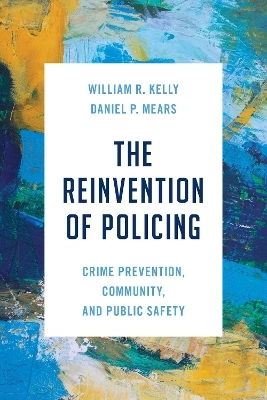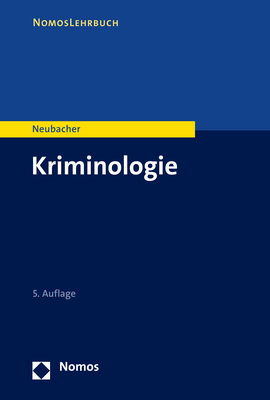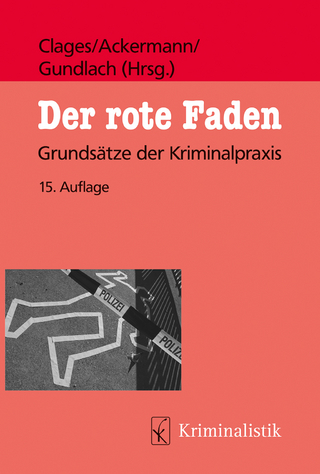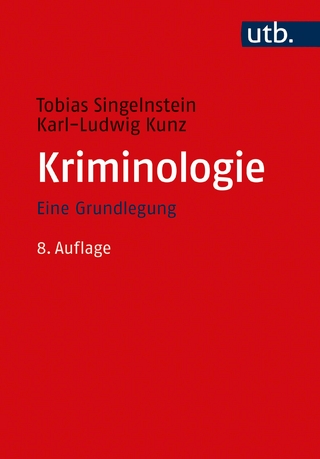
The Reinvention of Policing
Rowman & Littlefield (Verlag)
978-1-5381-7919-2 (ISBN)
Contemporary policing is in crisis, a situation that has led to persistent calls to reform it. Unfortunately, many proposed solutions focus on piecemeal changes that ignore a fundamental problem—policing relies on a largely reactive approach that does not in any systematic or comprehensive way focus on crime prevention. Most of what the police do, such as responding to 911 calls for service and employing directed patrols or hot spots policing, fails to address the causes of crime. Compounding this problem is the absence of any institution or agency charged with prioritizing the prevention of crime and for ensuring that police efforts support this goal.
Kelly and Mears argue that a better strategy exists, one that places responsibility on the police and other governmental and non-governmental agencies and organizations for truly preventing crime. Why, historically, did crime prevention not take hold and infuse policing? One reason is a design flaw—the vision of policing centered too much on surveillance and too little on efforts that target the diverse causes of crime. The end result? Contemporary policing lacks any institutionalized commitment or systematic approach to crime prevention. It is designed to fail.
The Reinvention of Policing diagnoses this problem, along with many others, in
American policing. Then the authors turn to solutions. First, they call for a great many reforms to existing practices. Second, they call for a reinvention of the design and focus of policing and, concomitantly, the way that states, cities, and towns approach public safety. This change presents special challenges, but it is the only way to create an appreciable impact in reducing crime and improving justice.
William R. Kelly is professor in the Department of Sociology and director of the Center for Criminology and Criminal Justice Research at the University of Texas at Austin. Kelly is the author of and contributor to several books and articles on criminal justice, law, and policy, including Criminal Justice at the Crossroads (2015), Confronting Underground Justice (2018), and The Crisis in the American Courts (2021). Daniel P. Mears is distinguished research professor in the College of Criminology and Criminal Justice at Florida State University. A fellow of the American Society of Criminology and recipient of the Bruce Smith Sr. award from the Academy of Criminal Justice Sciences, Mears conducts research on crime and policy. His work appears in journal articles and books, including the award-winning American Criminal Justice Policy (2010) and Out-of-Control Criminal Justice (2017).
Acknowledgements
About the Authors
Preface
1. Our Broken Criminal Justice System and the Failure to Put Public Safety First
The Costly Failure of American Criminal Justice
Fundamentally Misunderstanding Public Safety
Why Focus on Policing?
Improving Policing and Public Safety
Structure of this Book
2. American Policing: A Litany of Problems
Introduction
Critical Problems in Policing—Design Flaws
Problem 1: Society Thinks that They Have a Crime Prevention Agency—They Do Not
Problem 2: The Police Do Little to Address Known Causes of Offending or Crime
Problem 3: Goals and Mission Creep
Problem 4: Lack of Clarity about How Large Police Departments Should Be
Problem 5: Increasingly Militarized Police
Problem 6: Lack of Coordination with Courts and Resistance to Reform
Critical Problems in Policing—Harmful Impacts
Problem 7: Failure to Prevent or Reduce Crime
Problem 8: Use of Force: Problems, Effectiveness, and the Ridiculous
Problem 9: Racism, Ethnic Bias, and Profiling
Problem 10: Police Accountability, Citizen Oversight, and Qualified Immunity
Critical Problems in Policing—Operational Issues
Problem 11: Inadequate Officer Training
Problem 12: Police Discretion and Officer Supervision
Problem 13: The 911 System
Problem 14: Police Use of Time
Problem 15: Police Ill-Equipped to Manage the Consequences of Mass Reentry
Problem 16: Police Officers’ Attitudes about Their Jobs
Problem 17: Public Attitudes about Policing
Critical Problems in Policing—Lack of Research, Monitoring, and Oversight
Problem 18: Little Systematic Reliance on Research
Problem 19: Accountability and the “Black Box” of Policing
Conclusion
3. How We Got Here: Policing that Does Not Prioritize Public Safety (Co-authored with Madalena Almanza)
Introduction
Historical Origins of Policing
What Contributed to Expansion of Policing as a Reactive, Control-Oriented Institution
Crime
Civil Disorder and the Johnson Presidency
Tough on Crime
The 1994 Crime Bill
The War on Drugs
Mission Creep: Dumping More and More Responsibilities on Police
911 and Reactive Policing
Broken Windows
The Warrior Cop
Conclusion
4. A Clean Slate: What Would an Effective Public Safety Approach Look Like?
Introduction
Establish Clear Goals: Crime Prevention and Public Safety
Identify and Monitor the Level and Distribution of Recidivism and Crime
Identify and Monitor the Causes of Recidivism and Crime
Use Evidence-Based Strategies to Prevent Offending and Reduce Recidivism (Individuals)
Address Known Causes of Offending and Recidivism
Focus on Three Levels of Prevention
Rely on a Comprehensive Approach
Use Evidence-Based Strategies to Prevent and Reduce Crime (Communities)
Address Known Causes of Crime
Focus on Three Levels of Prevention
Rely on a Comprehensive Approach
Coordinate All Efforts
Rely on Continuous Research and Assessment
Assess and Improve Policy Design
Assess and Improve Policy Implementation
Assess Policy Impact and Cost-Efficiency
Assess Citizen Views and Experiences
Conclusion
5. Reforming Traditional Policing—Eliminating What Doesn’t Work and Keeping and Improving What Does Work to Promote Crime Prevention and Public Safety
Introduction
Improve Traditional Policing—What to Eliminate
Random, Preventive Patrol, Especially in Large Geographic Areas
Traffic Enforcement
Aggressive Policing, Zero Tolerance Policing, and Broken Windows Policing
Mental Health Calls
Police in Schools
Predictive Policing
Improve Traditional Policing—What the Police Should Do, Do More, and Do Better
911 Reform
Hot Spots Policing
Problem-Oriented Policing
Community Policing
Proactive Policing
Police Recruiting and Training
Police Culture: Transitioning from Warrior to Guardian
Conclusion
6. Reinventing Policing within a System that Prioritizes Crime Prevention and Public Safety
Introduction
Contemporary and Proposed Police Reforms
Reinventing American Policing to Accomplish Public Safety
Defining Crime Prevention
The Case for Crime Prevention
Crime Prevention Strategies by Law Enforcement in the U.S.
Crime Prevention Strategies by Law Enforcement in Other Countries
A New Model for American Policing
1. A Lead Agency Charged with Promoting Public Safety
2. Research Guidance on Crime and Its Causes
3. Multi-Agency Policing
4. Addressing Crime through Police Specialization and Improved Training
5. Crime Prevention through Collective Efficacy and Informal Social Control
6. Crime Prevention through Alternatives to the Police
7. Crime Prevention through a Systematic Approach
8. Crime Prevention through Improvement of 911 Call Systems
9. Leverage Public Support for Reinventing and Evaluating Policing
10. Research Evaluation of Implementation, Effectiveness, and Cost-Efficiency
What Has to Happen for the Reinvention of Policing to Be Successful
Address Barriers to Reinventing Policing
Create Incentives for Reinventing Policing
Reality: Pragmatic Considerations and Reinvention of American Policing
Conclusion
7. Better Policing and Public Safety Means More Justice
Introduction
What Is Justice?
What Do Police Reforms and the Reinvention of Policing Mean for Justice?
Conclusion
8. Conclusion: Public Safety First
Introduction
A Litany of Problems (Key Points from Chapter 2)
Why Policing Is Broken and Needs to Be Reinvented (Key Points from Chapter 3)
A Clean-Slate View of How to Improve Public Safety (Key Points from Chapter 4)
Reforming Policing (Key Points from Chapter 5)
Reinventing Policing (Key Points from Chapter 6)
Improved Public Safety Means More Justice (Key Points from Chapter 7)
Conclusion
Bibliography
| Erscheinungsdatum | 16.06.2023 |
|---|---|
| Co-Autor | Madalena Almanza |
| Verlagsort | Lanham, MD |
| Sprache | englisch |
| Maße | 159 x 237 mm |
| Gewicht | 603 g |
| Themenwelt | Recht / Steuern ► Strafrecht ► Kriminologie |
| Sozialwissenschaften ► Soziologie | |
| ISBN-10 | 1-5381-7919-9 / 1538179199 |
| ISBN-13 | 978-1-5381-7919-2 / 9781538179192 |
| Zustand | Neuware |
| Haben Sie eine Frage zum Produkt? |
aus dem Bereich


